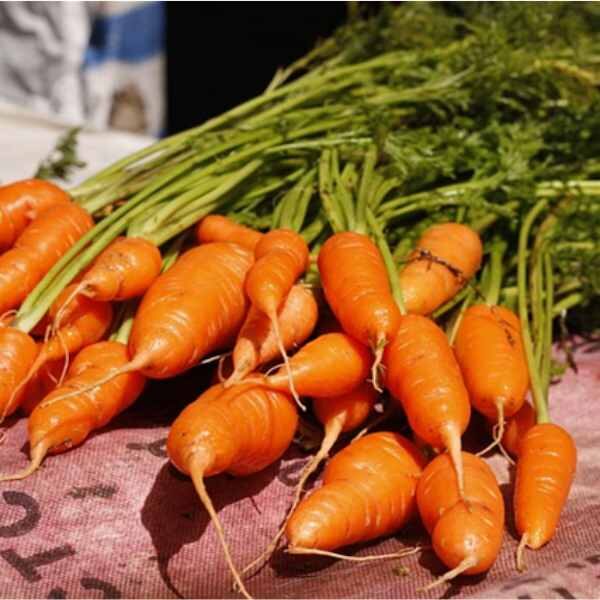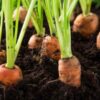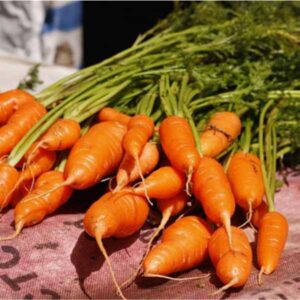Carrot Short Kuroda
$4.95
Daucus Carota
- Seed Count 300
- Good Variety For Poor Soils
- Biennial Grown As An Annual
In stock
Description
Carrot Short Kuroda produces high quality, uniform roots of great flavour, and is suitable for growth almost everywhere.
This stubby, thick-shouldered favourite yields smooth, uniform conical roots best harvested 12 to 15cm long and 5cm in diameter.
It has smooth skin, and a strong top, with green growth reaching between 18 and 25 cm.
It thrives in even the poorest of soils and is ideal for summer sowing with prolonged harvest through autumn and winter in temperate zones.
Carrot Short Kuroda keeps well in storage and is an awesome juicer.
| Method: Sow direct | Soil Temp: 8°C - 30°C |
| Cool Mountain: Sep - Feb | Position: Full sun |
| Arid: Jan - Dec | Row Spacing: 10cm apart |
| Temperate: Sep - May | Planting Depth: 3mm |
| Sub Tropical: Feb - May | Harvest: 60 days |
| Tropical: Apr - Jun | Plant Height: 13cm |
Basics
- Capsicum (sweet/bell Capsicum) thrives in warm, sunny gardens.
- Plant them in a spot with full sun (6+ hours) and rich, well-drained soil.
- Prepare the bed by removing weeds and digging in plenty of compost or aged manure.
- Use mulch around plants to retain moisture and suppress weeds.
Seed Trays vs Direct Sowing
Seedling Trays:
- Raise seeds in pots or trays filled with seedling mix, keeping them warm (16-35°C) and moist.
- This protected start speeds germination and gives plants a head start on weeds and weather.
- You’ll use fewer seeds and get sturdy seedlings for an earlier crop.
- The downside is extra effort and cost (pots, mix, heat source) and you must harden-off seedlings before planting out.
Direct Sowing:
- Plant seeds 3mm deep in the garden soil 50cm between plants, 60–100cm once it’s warm and frost-free.
- Direct sowing is simpler and cheaper (no trays or special mix), but germination is slower and more vulnerable to cold, pests or heavy rain.
- Capsicum seeds can take 1–3 weeks to sprout at 16–35°C.
- Ensure the soil stays evenly moist (not waterlogged) during this time.
In short: use trays if you want the best germination and an early start; sow direct if you prefer simplicity and have already warm conditions.
Planting and General Care
Timing & Spacing:
- Plant or transplant capsicum after all danger of frost has passed.
- In tropical/subtropical areas, Capsicums can even fruit year-round, but in cooler zones treat them as an annual summer crop.
Soil:
- Use well-drained, fertile soil rich in organic matter.
- Work in compost or aged manure before planting.
- Capsicums prefer a slightly acidic to neutral pH (~6.0–7.0).
- In pots, use at least ~40L per plant.
Watering:
- Water deeply and regularly, so the soil stays evenly moist.
- Check soil moisture by pushing a finger 4–5cm down; water when that layer is just dry.
- Water in the early morning or late afternoon to minimize stress.
- Avoid wetting the leaves, which can encourage fungal disease.
- Mulch around plants to keep roots cool and reduce evaporation.
Fertilising:
- If the soil was well-prepared, you may need little extra feed.
- Otherwise, apply a balanced (e.g. 10-10-10 NPK) slow-release fertilizer at planting.
- Once flowers and fruit start, give a liquid tomato or vegetable fertilizer every few weeks according to label directions.
- This supports heavy fruiting. Avoid excessive nitrogen late in the season, as it can reduce fruit set.
Staking & Pruning:
- Capsicum plants can get top-heavy with fruit. Stake or cage them when planting.
- A simple sturdy stake beside each plant works – gently tie the main stem (e.g. with soft string) as it grows.
- This prevents wind damage and keeps fruit off the ground.
- Remove any low or damaged leaves to improve air flow.
- Many gardeners also pinch out a few early flower buds when plants are young – this encourages stronger vegetative growth and heavier later yields.
- Overall, little pruning is needed beyond this.
Pest & Disease Management:
- Monitor plants for pests like aphids, caterpillars, slugs/snails, and chilli thrip.
- Hand-pick pests or use organic sprays if needed.
- Practice good hygiene: remove weeds and crop debris.
- Rotate capsicum/solanaceous crops to a different spot each year to reduce disease pressure.
- Common diseases include blossom-end rot (from inconsistent watering or low calcium) and fungal spots.
- Regular watering and mulch help prevent blossom-end rot.
- Crop rotation and not overcrowding plants also reduce problems.
Chilli Thrips: What They Are & How to Deal With Them
- Chilli thrips (Scirtothrips dorsalis) are tiny, slender insects that can cause big problems in home veggie patches—especially for capsicum, chilli, eggplant, and tomato plants.
- You might not see them easily (they’re less than 2mm long!), but the damage is easy to spot as leaves curl or look bronzed and scarred, buds drop off, and fruit can become deformed or scarred.
- These pests feed by piercing plant tissue and sucking out the juices, which leads to silvery or brown patches on leaves and distorted growth.
- They tend to hang out on the newest growth, flower buds, or the undersides of leaves—so grab a magnifying glass and check these spots first if your plants are looking stressed.
What You Can Do:
Prevention is key:
- Start clean – Avoid bringing in infested seedlings or cuttings.
- Attract beneficial bugs like lady beetles, lacewings, and predatory mites—they’ll help keep thrip numbers down.
- Plant flowers like alyssum, marigold, or dill nearby to draw in the good guys.
If they show up:
- Prune affected areas early to stop the spread.
- Hose them off gently with water to dislodge thrips from foliage.
- Apply insecticidal soap or horticultural oil, covering all leaf surfaces, especially underneath. Repeat weekly as needed.
- Rotate your crops each year to disrupt their lifecycle.
Tip: Thrips love hot, dry conditions—so keep your plants well-watered and mulched to reduce stress and deter infestations.
Companion Planting with Capsicum
Good companions:
- Herbs & Flowers: Basil, dill, parsley, coriander, chamomile and other aromatic herbs as they attract beneficial insects and may repel aphids or whiteflies. Garlic, onions, chives as their strong scent deters many pests. Marigolds, nasturtiums, borage, lavender as these flowers lure pollinators and trap pests (marigolds are famous for nematode control).
- Vegetables: Carrots, lettuce, spinach as they occupy shallow roots and don’t compete much with Capsicums. These can provide light ground cover under Capsicum plants. Tomatoes are sometimes planted alongside Capsicums (both like similar conditions) but be aware they share some pests/diseases so give them space and rotate beds regularly.
- Fruits: Strawberries and cucumbers have been noted as decent neighbours (shallow roots and shade from cucumber leaves can protect Capsicums).
Bad Companions
- Other heavy feeders or close relatives.
- Do not grow next to eggplants, potatoes or tomatoes in succession, as they share pests/diseases.
- Stay away from beans/peas and plants like fennel or dill, which can inhibit Capsicum growth.
- Squash and pumpkins (deep-rooted cucurbits) can out-compete Capsicums for nutrients.
- In short, pair Capsicums with light-feeders and pest-deterring plants, and keep them apart from other nightshades and big gourds.
Seed Saving
Saving your own Capsicum seeds is easy if you follow a few simple steps:
Select plants:
- Pick the healthiest plants with strong, typical fruit.
- If growing multiple types, isolate them (e.g. bag flowers or keep 20m+ apart) to prevent cross-pollination.
Harvest ripe fruits:
- Wait until Capsicums are fully ripe on the plant which is usually when they’ve changed to their final colour and just start to soften or wrinkle.
- Allowing fruits to over ripen a little ensures the seeds are mature.
Extract seeds:
- Cut the Capsicum in half and scoop or twist out the central core.
- Scrape out the seeds and remove as much of the inner flesh and pith as possible.
- Rinse the seeds in clean water to wash off any remaining pulp which helps them dry cleanly.
Dry seeds:
- Spread the seeds in a single layer on paper towels or a clean plate in a dry, shaded place.
- Let them dry completely over several days.
- They’re ready when you can crunch a seed in your fingers and it snaps rather than bends.
- Moisture is the enemy of seed storage, so make sure they feel fully dry.
Store seeds:
- Transfer the dried seeds to a paper envelope or small jar with a tight lid.
- Label with variety and date.
- Store in a cool, dark, dry spot (a refrigerator works well).
- Properly stored Capsicum seeds remain viable for about 3–4 years, so you’ll have plants for many seasons.
Ideal Growing Conditions
Climate:
- Carrots prefer moderate temperatures and grow best between 15°C to 20°C
- They tolerate light frost but may become bitter if exposed to extreme cold.
Soil:
- Well-draining soil is crucial. Sandy loam is the best, as it allows for free root expansion.
- Avoid heavy clay soils, which can cause deformities in the roots.
- Prep the soil by removing stones, weeds, and debris to a depth of at least 30 cm.
pH:
- The ideal pH range is between 6.0 and 6.8.
- If your soil is too acidic or alkaline, consider adding lime or sulphur to adjust the pH.
Planting Carrots
Timing:
- In most parts of Australia, carrots can be sown from late summer through to spring.
- Consider the local climate; in milder regions, sowing can be done all year round.
Seed Preparation:
- Carrot seeds are small. Mixing them with sand can help distribute them evenly when planting.
Sowing:
- Sow seeds directly into the garden bed. Plant 3 mm deep, and lightly cover with soil.
- Space seeds about 10 cm apart within rows that are 10 cm apart.
Covering:
- Lightly mulch after planting to retain moisture and suppress weeds.
Watering and Care
Watering:
- Keep the soil consistently moist, especially during germination (around 2-3 weeks).
- Watering deeply but infrequently encourages deeper root growth. During dry spells, consider watering every few days.
Thinning:
- Once seedlings are about 10 cm tall, thin them so that they are spaced about 10 cm apart. This prevents crowding and ensures larger root development.
Fertilising:
- Use a balanced fertiliser or one low in nitrogen to avoid excessive foliage and focus on root growth.
- A side-dressing of compost along the rows can provide additional nutrients.
Weed Control:
- Keep the area weed-free to minimize competition for nutrients and water. Hand-pull weeds carefully to avoid disturbing carrot roots.
Companion Planting with Carrots
Onions and Garlic:
- These plants help repel carrot flies, one of the primary pests affecting carrots. The strong scent can confuse the flies and deter them from laying eggs near carrots.
Leeks:
- Like onions and garlic, leeks can help ward off pests while also making efficient use of garden space.
Tomatoes:
- Tomatoes can benefit carrots by providing shade, especially in warmer weather. They also help repel certain pests.
Lettuce:
- Lettuce grows quickly, allowing for effective space use. It can provide some shade for young carrots, helping to maintain soil moisture.
Radishes:
- Fast-growing radishes can be interplanted with carrots. The radishes will mature quickly, and as they are harvested, the carrots will have more space to grow.
Beans:
- Planting legumes like bush beans can fix nitrogen in the soil, which can benefit carrots. However, ensure they do not overshadow the carrots.
Marigolds:
- These flowers are excellent companions as they deter various pests, including nematodes. Their flowering can also attract beneficial insects to the garden.
Plants to Avoid
Dill:
- While this herb is fine to grow, avoid planting it too close to carrots, as they can compete for nutrients and may attract certain pests.
Celery:
- Like dill, it can compete for nutrients and may not be beneficial to neighbouring carrots.
Fennel:
- Fennel is known to be allelopathic, meaning it can inhibit the growth of surrounding plants, including carrots.
Planting Arrangement Tips
Intercropping:
- Use intercropping techniques to maximize garden space and productivity. For example, plant fast-growing radishes in between rows of slower-growing carrots.
Row Planning:
- Alternate rows of carrots with their companion plants. For example, you might plant a row of carrots followed by a row of onions or marigolds.
Vertical Space:
- Consider using vertical space efficiently. Taller plants (like tomatoes) can be placed on the northern side of carrots to minimize shading.
Pest and Disease Management
Common Pests:
- Carrot fly: Use floating row covers to prevent female flies from laying eggs at the soil surface.
- Aphids: Regular inspections can help. Use insecticidal soap if numbers are high.
Diseases:
- Fungal diseases: Ensure adequate spacing and airflow around plants. Crop rotation can also help reduce disease risk.
Harvesting
Indicators:
- Carrots are typically ready to harvest 60 days after sowing. Feel the tops to judge size. Ideally, they should be about 2.5 cm in diameter.
- Harvest them early for baby carrots or leave them to reach full size.
Harvesting Method:
- Loosen the soil around the carrot with a fork before pulling them out to avoid breaking the roots.
- Gather during dry weather for easier handling.
Storage
Short-Term:
- Store unwashed carrots in the fridge in perforated plastic bags. This maintains moisture and crispness.
Long-Term:
- For long-term storage, they can be kept in wooden boxes filled with sand in a cool, dark place.
Additional Tips
Succession Planting:
- For continuous harvests, practice sowing seeds every 2–3 weeks.
Postage Charge
Orders under $30 attract a $4.95 shipping charge. Orders $30 and above have free shipping.
Order Times
Seed orders are normally dispatched within three business days. You will receive an email when seeds are mailed out.
Postage Days
Seeds are mailed out Monday to Friday at 1pm. Except for the Friday of long weekends.
Postage Times
WA 2-3 Days: SA,NT 3-5 Days: NSW, ACT, QLD, VIC: 5-7 Days
Carrier
We use Australia Post Letter Postage for the majority of orders
Not only are our seeds packed in recycled paper envelopes, we keep the theme going when we post out website orders. To protect your seeds from moisture and the letter box munchers (snails), we use a very special plastic free material made from plants. They are then put into recycled mailing envelopes. Green all the way 💚🌿












1 review for Carrot Short Kuroda